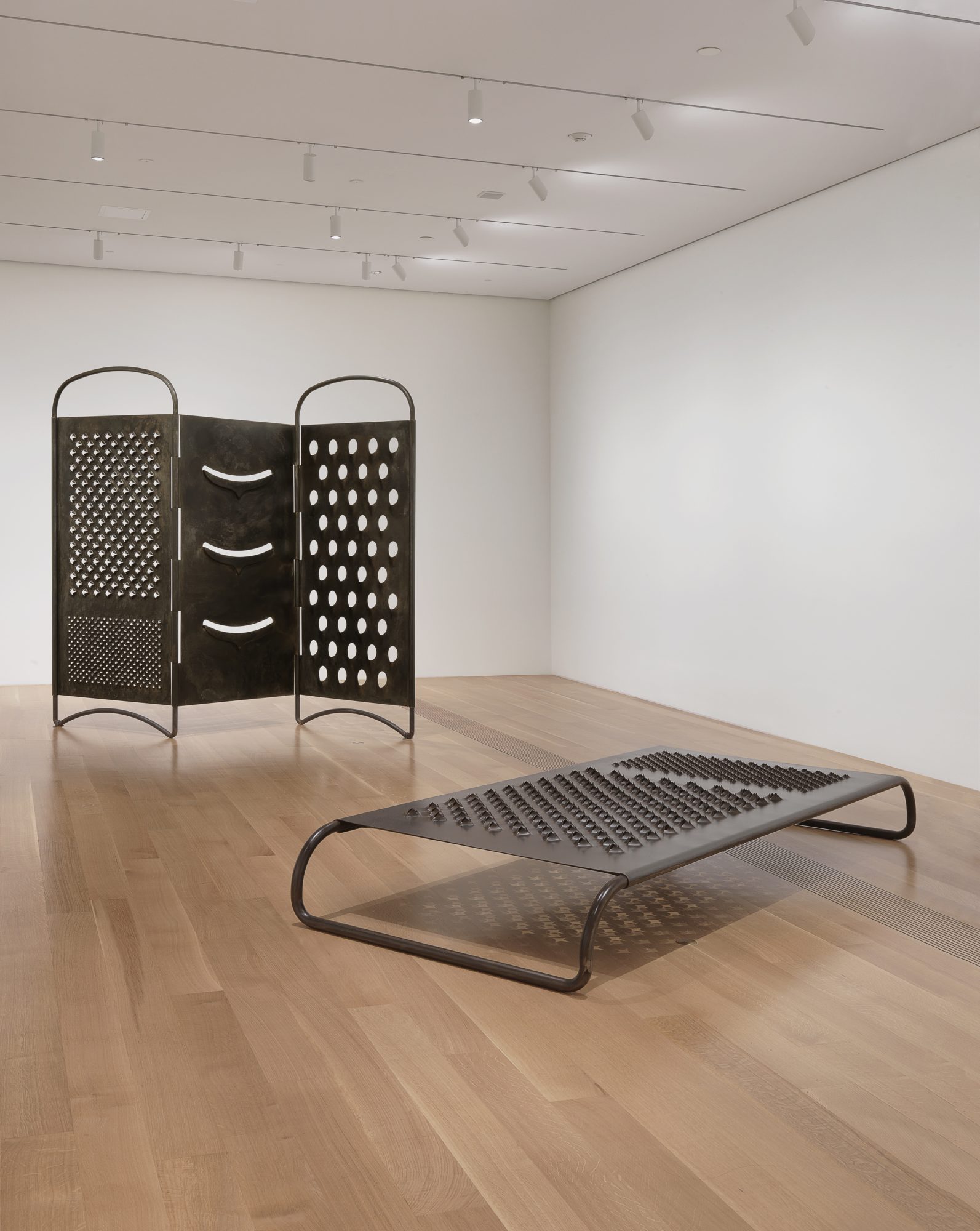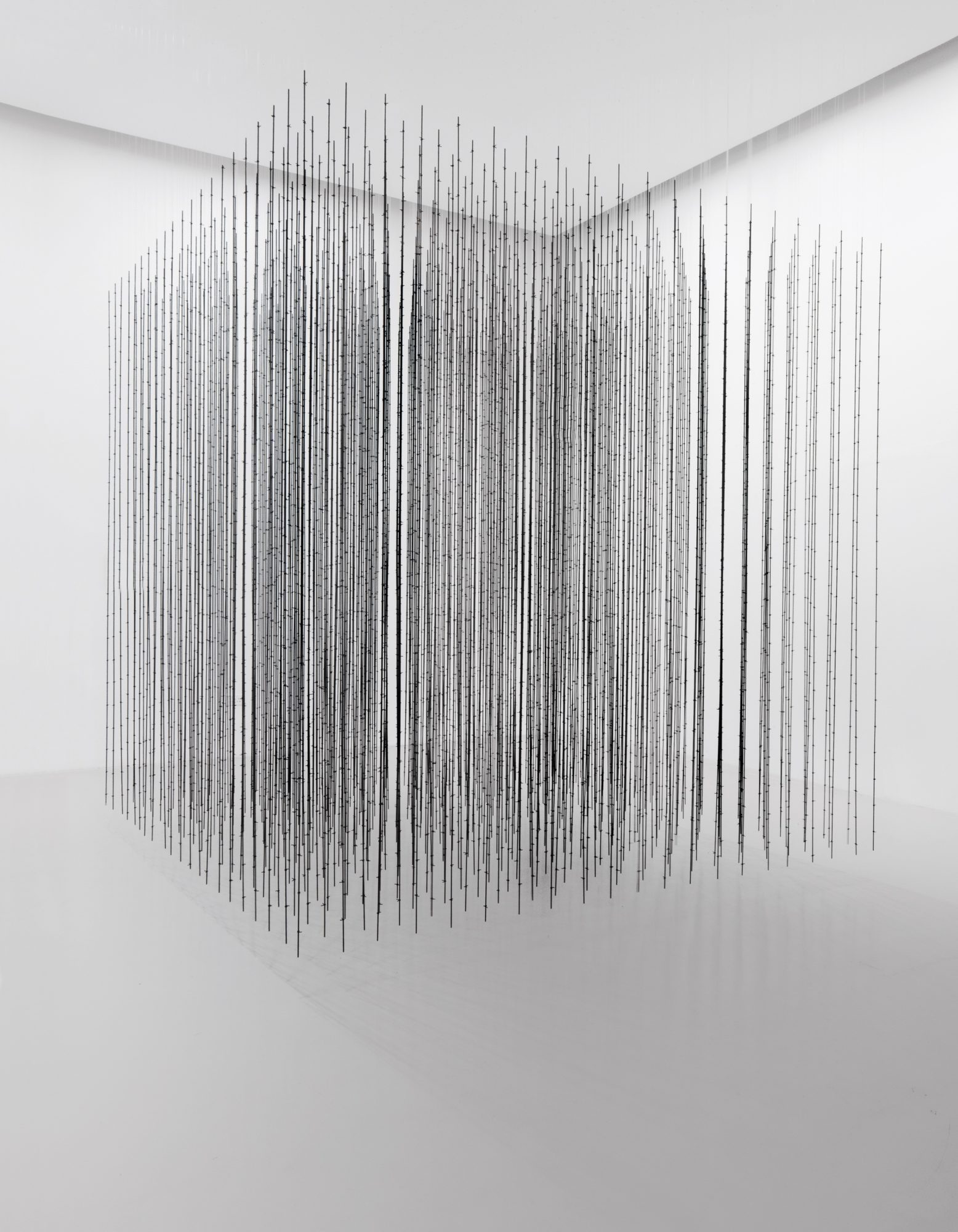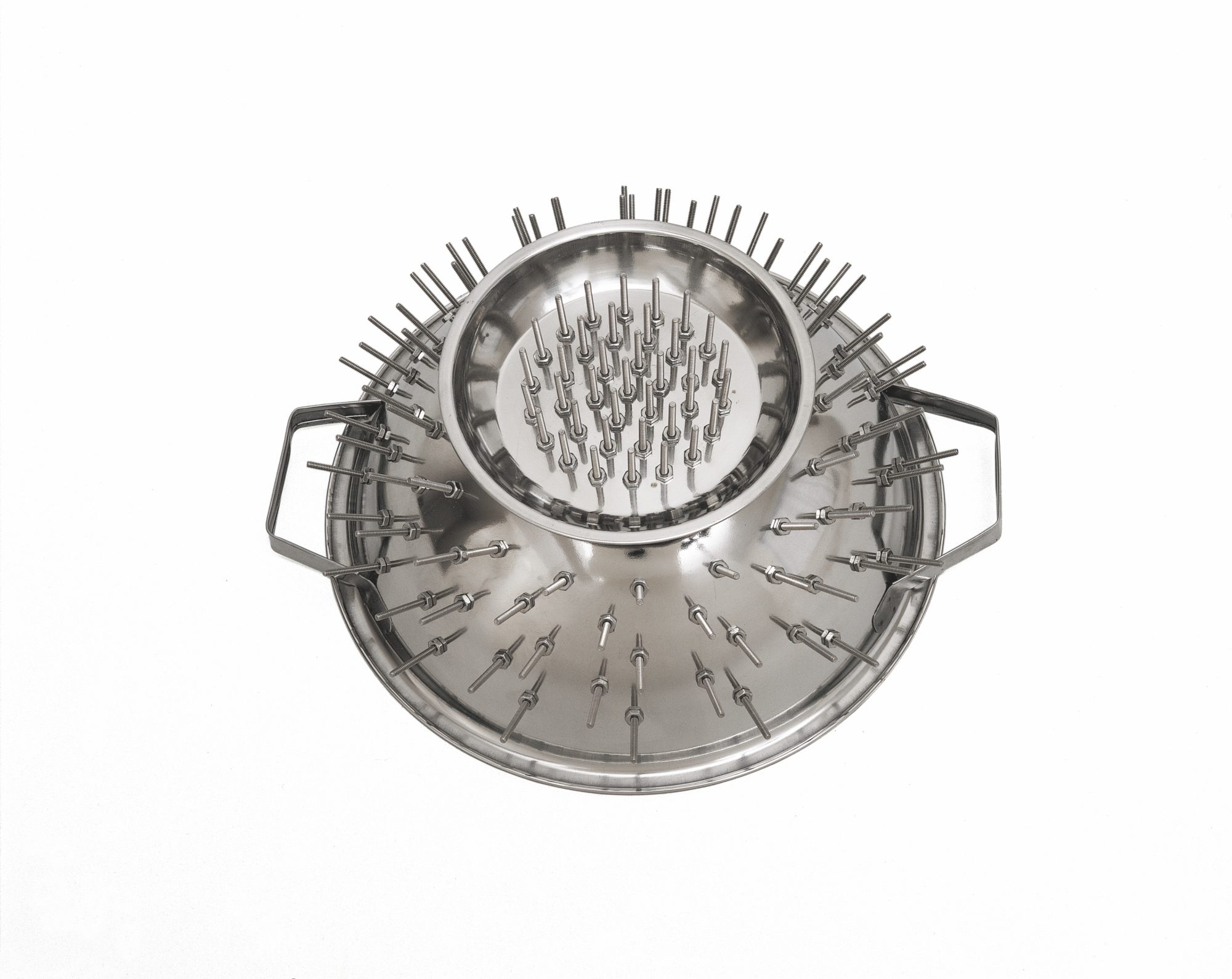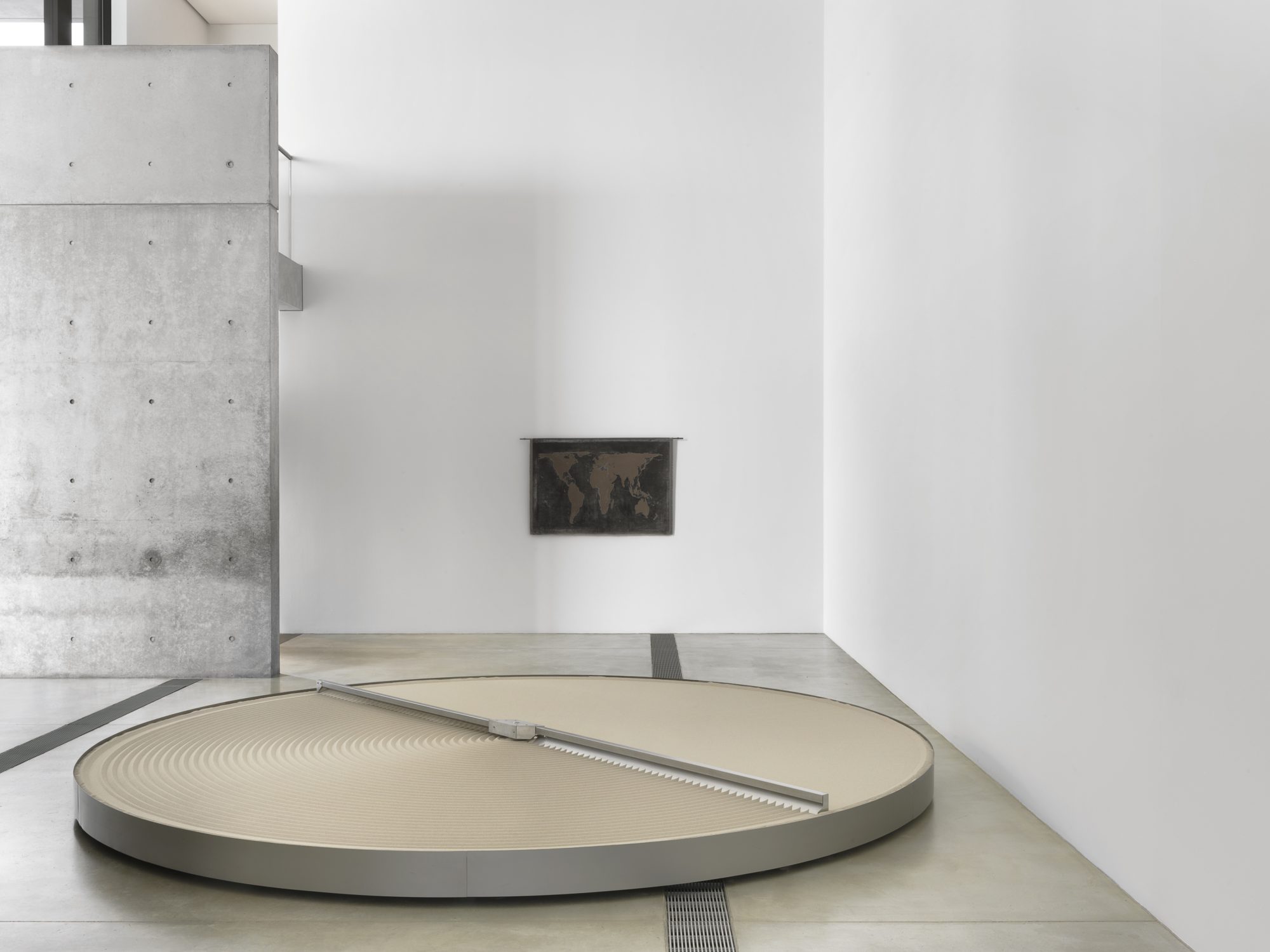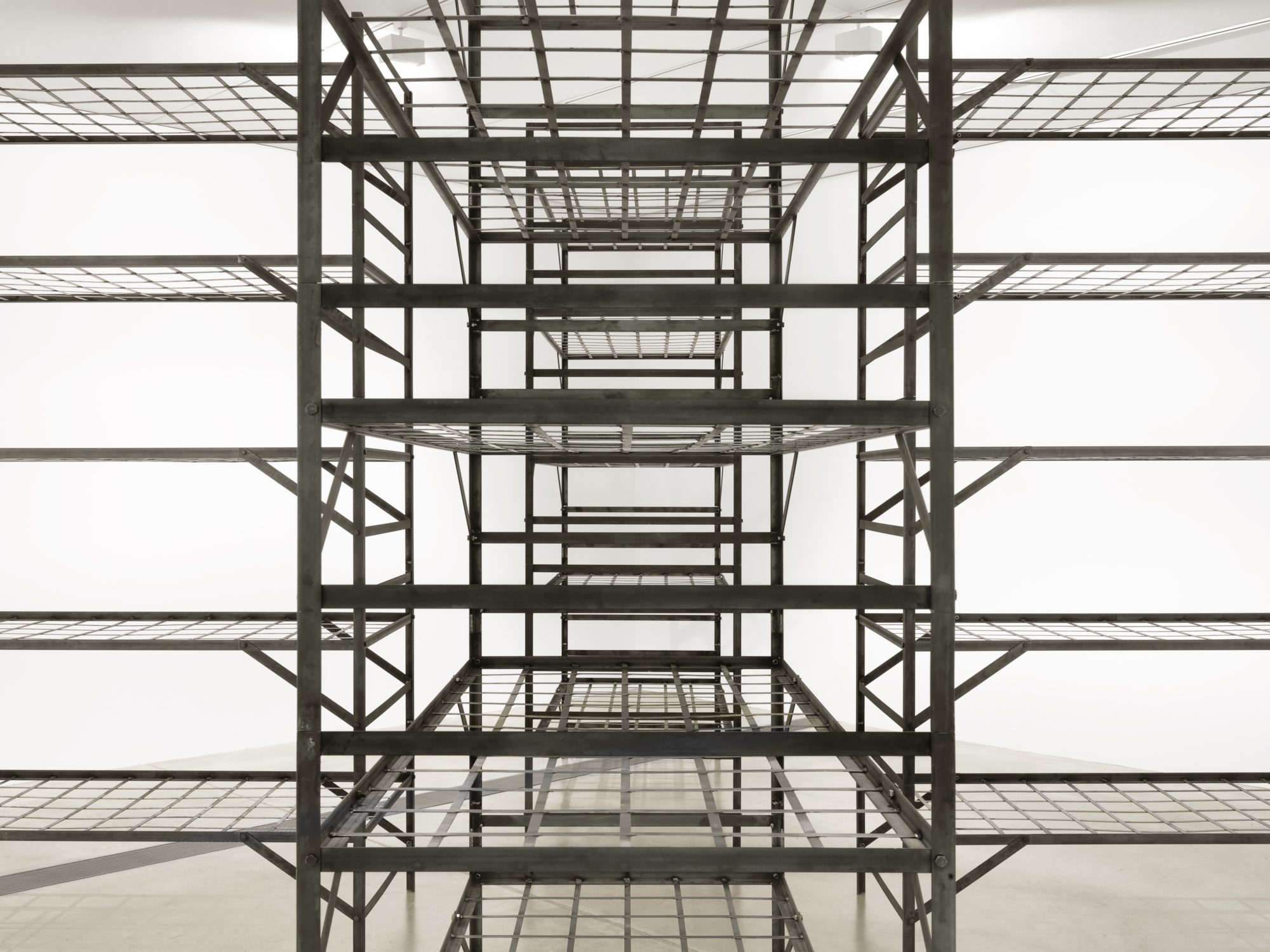Mona Hatoum: Terra Infirma
Mona Hatoum, Misbah, 2006–07, brass lantern, metal chain, light bulb, and rotating electric motor, dimensions variable [photo: Agostino Osio; courtesy of the artist and Fondazione Querini Stampalia Onlus, Venice]
Share:
Entering the Pulitzer Arts Foundation to view Mona Hatoum: Terra Infirma, which was organized by the Menil Collection in Houston, one immediately experienced an early video work from 1983, So Much I Want to Say. Its voiceover of Hatoum repeating the declaration, “So much I want to say” loops throughout the four-minute video, which shows a series of shifting black and white images of Hatoum’s face partially covered by another’s hands, continually gesturing to restrain her. The repetition of these six words—a minimalist lyric poem wherein Hatoum’s responses to global disorder are given primal linguistic flow—signifies a deep well of emotion and longing that resonate throughout this survey covering 35 years of the artist’s work. This now technically modest video served as a moving preface to Hatoum’s formidable work in subsequent years. It functioned likewise within the exhibition, where it was both preamble and postscript, as one also departed by the point of entry, suggesting to the viewer that the about what of Hatoum’s “so much” is considerable and ongoing. Undeniably it is, especially in the context of today’s contagion of nationalist self-interest, refugee crises, and genocides. Born in Beirut, Lebanon, to a Palestinian family, Hatoum has lived in London since 1975, when she was stranded there because of the outbreak of the Lebanese Civil War. Her personal context of displacement—punctured by myriad issues of home, borders, and identity—provides a lens through which Hatoum empathetically and critically considers the history and contemporary moment of political injustice and uncertainty—a spiraling of global events fueled by fierce nationalisms and xenophobia
Terra Infirma, installation view, 1994-2004 [photo: Alise O’Brien Photography; courtesy of the artist and Pulitzer Arts Foundation Collection Albright-Knox Art Gallery, Buffalo, New York]
Mona Hatoum, Impenetrable, 2009, black finished steel and fishing wire, 118.13 x 118.13 x 118.13 inches [photo: Markus Elblaus; courtesy of the artist and Arab Museum of Modern Art and Solomon R. Guggenheim Museum, New York]
The about what of So Much I Want to Say is frequently given semiotic form in sculptural works and installations that replace the face, voice, and hands of the 1983 video work with primitive machine-like forms or surrealist mechanisms, some newly fabricated in metal or glass, and others assembled from appropriated, prefabricated objects. Whereas representation of the human body is absent in Hatoum’s work, it is always present conceptually through objects such as common household implements or gloves, as in Homebound (2000) and Chain (1999), or by shifts in scale that interpose the body. For example, the steel sculpture La grande broyuese (Mouli-Julienne x 17) (1999) is made in the precise form of an antique food mill from Hatoum’s mother’s kitchen that has been enlarged seventeen times, so that it is 11 feet in height, almost 19 feet long, and more than 8 feet wide. Three ancillary objects are on the floor nearby: interchangeable discs for the mill, each more than five feet in diameter, with the potential to slice and strain with various results. The surprising, surrealistic shift in scale transforms an ordinary kitchen utensil into a grim death machine, perhaps something from a gothic fairy tale.
Mona Hatoum, No Way III, 1996, stainless steel, 4.25 x 9.75 x 11.13 inches; [photo: Edward Woodman; courtesy of the artist]
For Hatoum, the mechanistic—the imagery of an apparatus—signifies the systems, structures, and determined hierarchies of ideologies: cultural and political narratives that breathe through society, propelling regulations, establishing conventions, and impelling actions. Often propagated and embedded for social control and protection of the powerful and elite, ideologies succeed in practice through individuals’ self-delusions of autonomy. Referring to humans’ predisposition to make sense of the world through the construction of narratives and beliefs, cultural critic Louis Althusser stated in his discussion of the ideological state apparatus, interpellation, and the ideological effect that “[we] live ‘spontaneously’ and ‘naturally’ in ideology ….” Aligned with the perception that we are susceptible to and unwitting victims of ideology and its apparatus—frequently mechanisms of the state—Hatoum’s art suggests that ideologies/political mechanisms are not to be taken for granted but should be questioned and critiqued. From beginning to end the works in Terra Infirma functioned as a collection of gothic tales revealing the inevitability of injustice and cruelty produced by political power and its ideologies. Hatoum’s haunting visual metaphors resonate with the truths and dark hymns of Gramsci, Althusser, and Foucault, all cultural critics who interrogated power. For her the past, present, and inevitably the future reveal predictable cycles of inequality and xenophobia—a churning of the ubiquitous binary of the powerful and the people, of oppressors and victims.
Terra Infirma, installation view, 1994-2004 [photo: Alise O’Brien Photography; courtesy of the artist and Pulitzer Arts Foundation Collection Albright-Knox Art Gallery, Buffalo, New York]
A signature kinetic sculpture by Hatoum, + and – (1994–2004), is at once contemplative and sobering, an aesthetic locus for meditation that unobtrusively reveals machinations of political power. The work’s meditative quality is derived through steady cycles of inscription and erasure attained by a single rotating bar, a kind of clock’s hand pivoting at the center of a shallow, circular aluminum palette of dry sand. The gleaming industrial hand is nearly the length of the circle’s 14-foot diameter, half of its span consisting of sharp, symmetrical steel blades that inscribe or rake the sand, and the other half a flat steel plane that rests on the sand, eradicating the preceding inscription to leave a perfectly smooth surface. The continuous mechanized rotation of the hand yields a sonorous quality as it interacts with the sand, the curious muffled friction of power and pressure. While functioning as a quietly insistent metaphor for cycles of destruction and construction—a Zen-like visualization of the permanence of impermanence—the sobering quality of + and – occurs through political connotations of the two distinct wakes of the steel hand, and through the malleability (not to say pliance) of the sand, a poetic surrogate for the governed. Emphasizing the trail of something that has preceded, the concept of a wake signifies the aftereffects of a blunt initial impact or gesture, the challenging and often tragic consequences of misguided political action that linger and beg for solution. A wake is also a period of solemn waiting, a vigil for those who are gone or have disappeared, a distressing interstitial span that can feel or become permanent.
Mona Hatoum, Quarters, 1996, installation detail, mild steel, 108.50 x 203.50 x 203.50 inches [photos; Alise O’Brien; courtesy of the artist and Pulitzer Arts Foundation and Dallas Museum of Art]
As visual metaphors for the machinery of ideology and cyclic abuses of power, many of Hatoum’s works function universally, their aesthetic grounding providing enduring and crossover relevance to various events and issues in history. Impenetrable (2009), for example, addresses the 70-year wake of tragic events in the Israeli-Palestinian conflict as it does the culture of horror within Nazi concentration camps. Made of more than 400 vertically oriented lengths of barbed-wire, the sculpture forms a cube that is almost 10 feet on each side. Each piece of barbed-wire is suspended from the ceiling by clear plastic filament so that the bottom of each piece hovers a few inches from the floor. The multiple lengths of filament shimmered as they reflected the gallery lighting and created an aura above the impenetrable barbed-wire matrix, as the base of the cube seemed to hover supernaturally. As beautiful as it is threatening, Impenetrable is also an object of transfiguration as it rouses abhorrence, intimidation, and fear. Thus the sculpture is in dialogue with current events in the Middle East, signifying the emotions, tensions, and tragedies experienced at the Gaza Fence by Palestinians—for them a symbol of injustice even as it is a destination for martyrdom. The New York Times reported in May 2018: “Across the Gaza Strip on Monday morning [May 14], loudspeakers on minarets urged Palestinians to rush the fence bordering Israel, where they were met by army snipers.” Between March 30 and May 14, 2018, over 100 Palestinians were killed and thousands injured along the fence, with May 14 being described as “the worst day of carnage there since Israel invaded Gaza in 2014.”1 The bitter divide between the Israelis and the Palestinians at the Gaza Strip, sometimes referred to by human rights advocates as an open-air prison, is perhaps most emblematic of our contemporary terra infirma. Terra Infirma at The Pulitzer taught while it haunted, bringing Gaza into our hearts as our minds confronted the machinery of ideology.
References
| ↑1 | David M. Halbfinger, “Killings In Gaza, New Embassy In Jerusalem, And Peace As Distant As Ever”, May 14, 2018. Nytimes.Com. https://www.nytimes.com/2018/05/14/world/middleeast/israel-gaza-jerusalem-embassy.html. |
|---|
